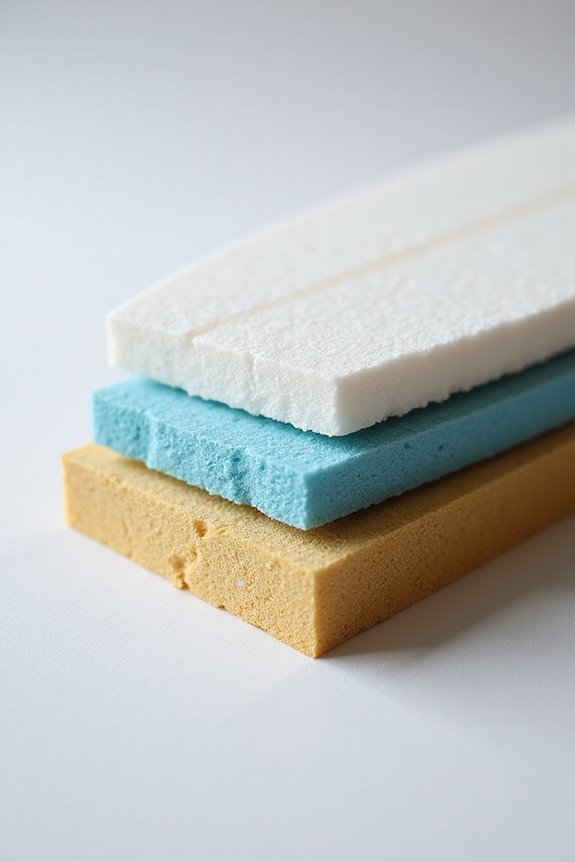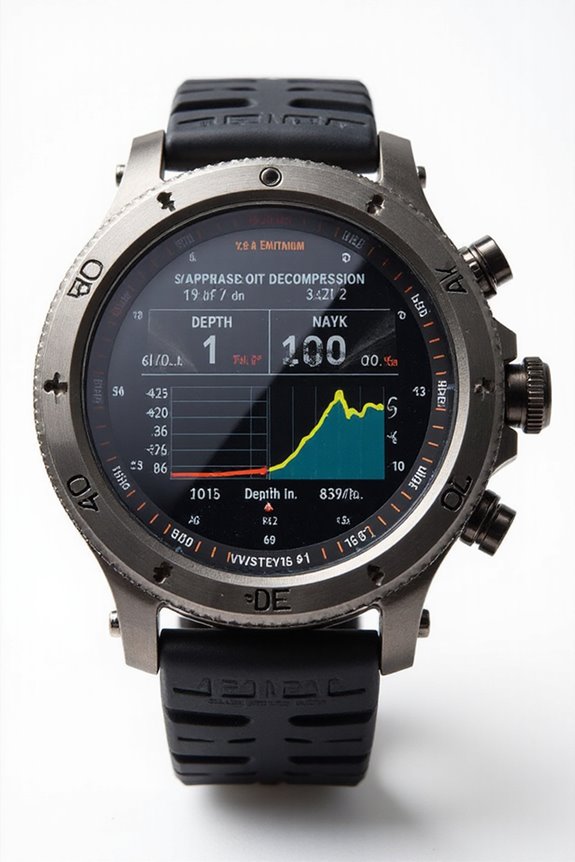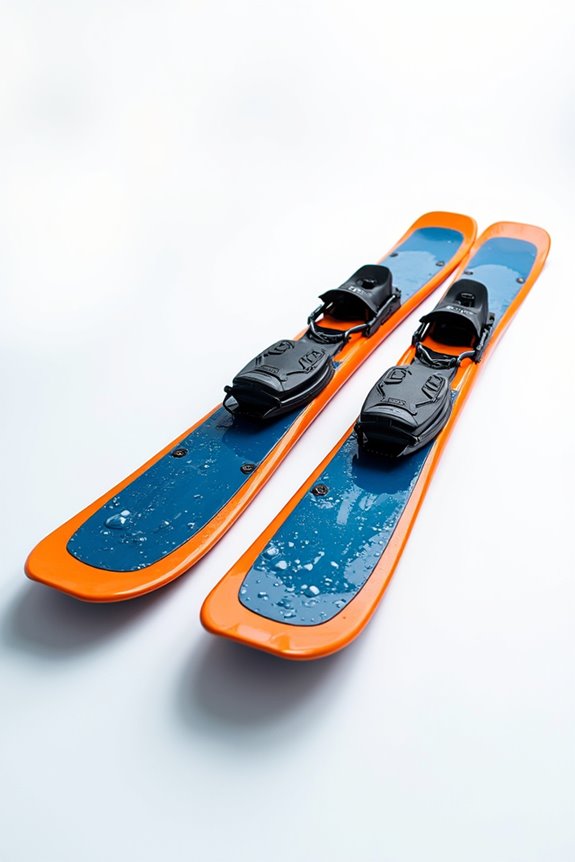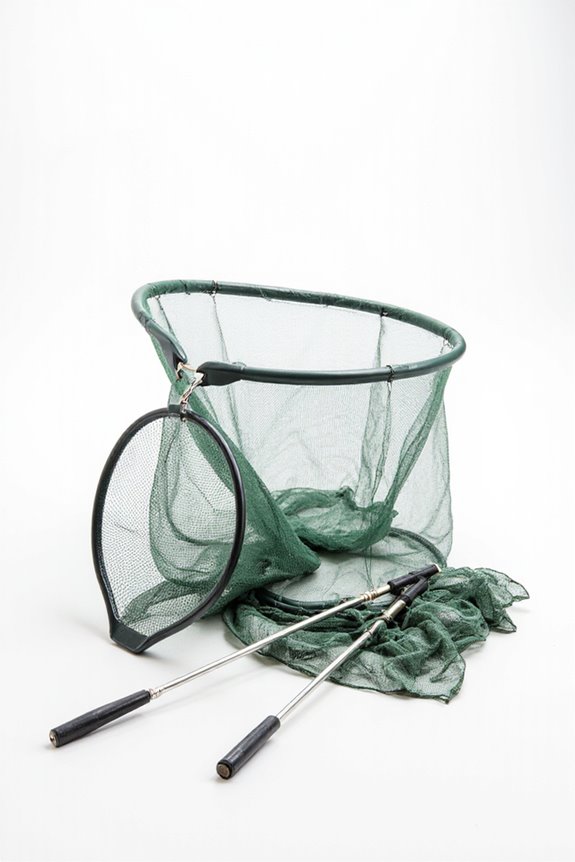When it comes to surfboard foam construction, we’re dealing mainly with PU and EPS foams—PU’s flexible and gives great feel, while EPS is lighter but stiffer, needing epoxy resin. Shaping is an art, from hand tools like rasps to precise CNC machines that carve complex designs rapidly. Molded foam tech speeds production but can limit customization. Want to know how stringers enhance strength or why resin choice matters? Stick around; there’s plenty more to explore.
Key Takeaways
- Surfboard foam types include PU for flexibility, EPS for lightness, and soft top foam for durability and beginner-friendly use.
- Shaping techniques involve outlining, cutting, planing, rasping, sanding, and defining the rocker curve for board performance.
- CNC machines enable precise, consistent shaping of complex designs using software like Shape3D, increasing production speed and accuracy.
- Molded foam technology offers cost-effective, consistent boards but limits customization and depends on mold quality for finish.
- Hand-shaping requires skilled foam shaving with hand planes and sanders, blending function and artistry to create unique custom boards.
Types of Foam Used in Surfboard Construction
When it comes to building a surfboard, the type of foam used for the core is a big deal—think of it as the board’s skeleton. We’ve got PU foam, known for its flexibility that offers great surfer feedback, but with some PU disadvantages like being heavier and prone to dents. On the flip side, EPS foam brings serious advantages, such as lighter weight and greater board strength, though it can be stiffer and needs epoxy resin. Soft top safety is another major plus, especially for beginners, with its water-resistant, durable foam covered by EVA for extra protection. Finally, molded EPS boards offer a consistent shape and quality, thanks to vacuum-pressed construction, giving us more reliable performance without guessing what we’ll get. It’s all about picking the right fit for your style and needs.
Methods for Shaping Surfboard Foam Blanks
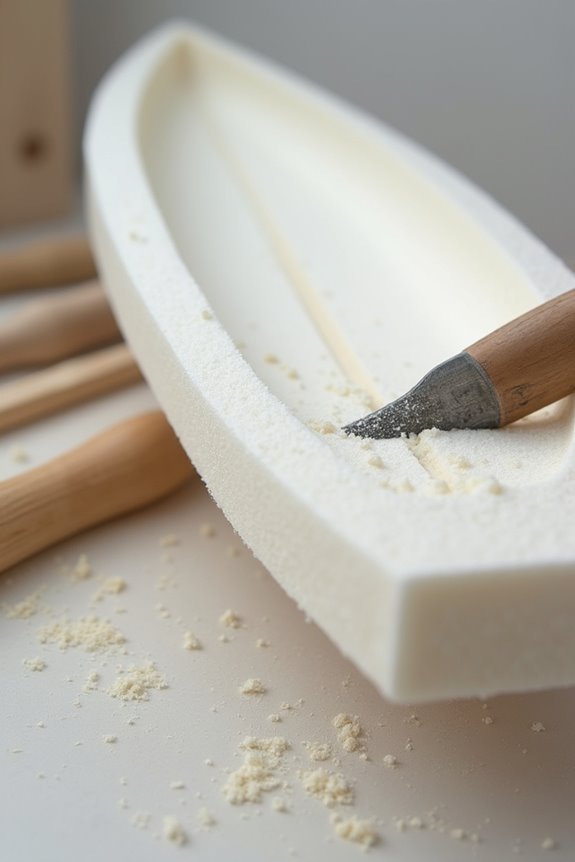
Choosing the right foam for your surfboard core sets the stage, but shaping that foam blank? That’s where the magic happens! We start by drawing the outline, then carefully cutting and planing the foam to get the perfect thickness. Foam shaping techniques like rasping and sanding help refine the edges and create that smooth finish we all want. Ever heard of rocker? It’s the curve that really defines how your board moves—and we shape it carefully, keeping surfboard design principles in mind. Tools like the Rasputin Rasp and sanding blocks become our best friends. Together, these steps mold a blank into a board that feels like an extension of us—ready to ride waves and join the community of passionate surfers we all belong to.
Role of CNC Machines in Surfboard Design
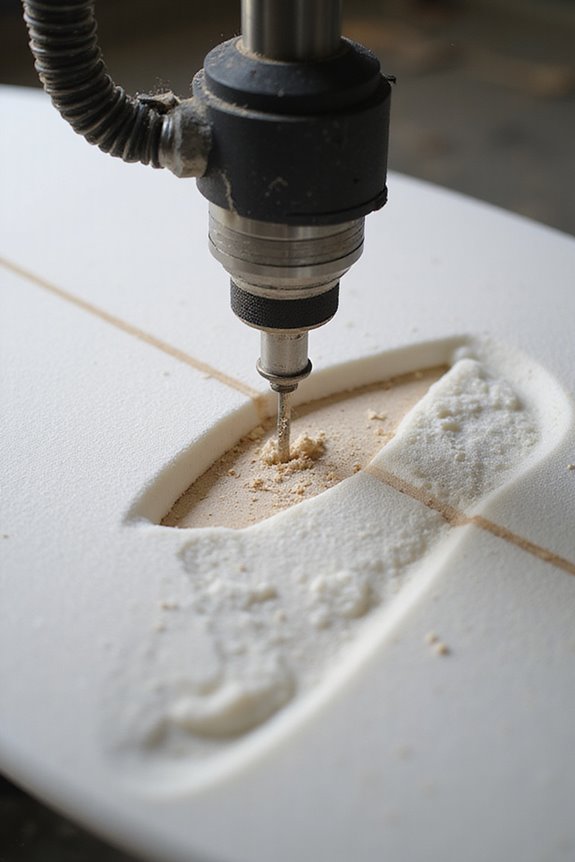
Although traditional hand shaping has its charm, CNC machines have stormed the surfboard design scene and changed the game for good. Thanks to CNC advancements, we now enjoy automated precision that’s hard to beat, especially when crafting complex shapes or maintaining consistency across multiple boards. These machines—like routers and hot wire cutters—follow computer-driven instructions from design software such as Shape3D, letting us tweak every curve with incredible accuracy. Ever wonder how manufacturers produce identical boards at scale without losing that custom feel? That’s CNC magic. Plus, the combination of tech and craft means we get faster production times, from rough shaping to finishing touches. In our surfboard community, embracing these tools doesn’t replace artistry; it enhances it, making quality designs more accessible and reliable for everyone.
Benefits and Challenges of Molded Foam Technology
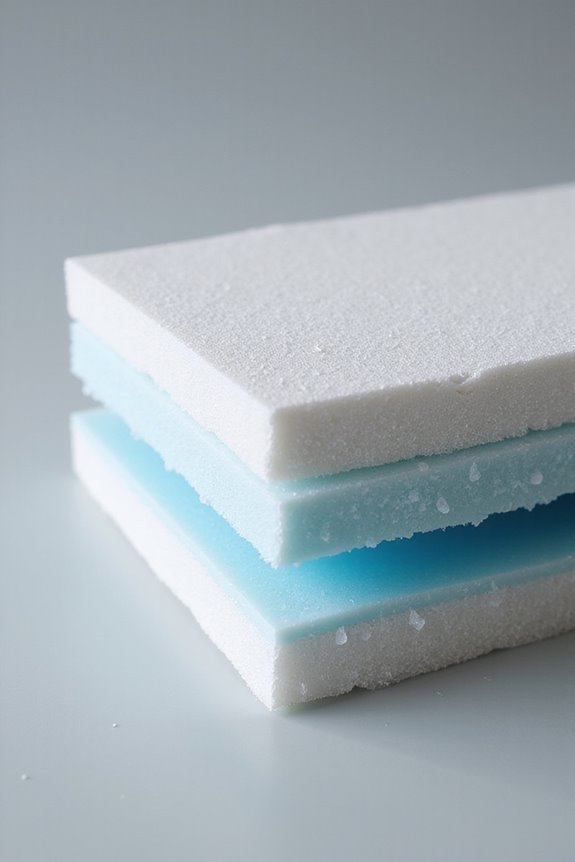
CNC machines have certainly brought a high-tech edge to shaping surfboards, but not every innovation sticks to cutting and carving. Take molded foam technology—it’s a game changer with some serious molded foam advantages. For one, it’s cost-effective, speeding up production and ensuring every board is consistently shaped. Plus, using EPS foam and epoxy resin brings environmental perks and durability. Sounds ideal, right? Well, there are molded foam drawbacks too. Customization is limited since new molds are needed for changes, and the mold’s quality directly affects the board’s finish. Also, mass production can feel less personal, which might not sit well with those craving a unique ride. So, while molded foam offers efficiency and eco benefits, it’s not the perfect solution for every surfer or shaper.
Hand-Shaping Techniques for Custom Surfboards
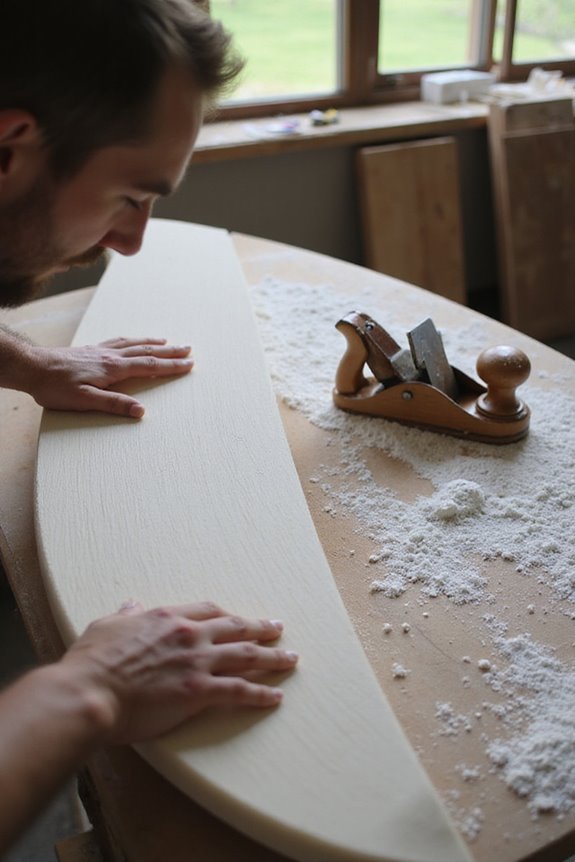
When it comes to crafting a truly unique surfboard, nothing beats the hands-on art of hand-shaping. We start by carefully shaving the foam block, following our chosen outlines—whether classic designs or bold new shapes—using various tools like hand planes and sanders. This subtractive process demands patience and precision, as every cut and contour affects how the board will perform on the waves. Hand shaping techniques allow us to fuse function with custom board aesthetics, giving each board its own personality. And hey, there’s something satisfying about sanding down that nose or tail until it’s just right, isn’t there? Ultimately, this blend of skill and artistry means every board tells a story—reflecting both the surfer’s style and our craftsmanship. Ready to make your mark in the lineup?
Structural Reinforcement With Stringers and Wood Frames
Since a surfboard’s strength and performance hinge largely on what’s inside, structural reinforcement plays an essential role in construction. We rely on stringer materials like spruce or cedar, placed right down the center, to control flex and give the board backbone. Ever wonder why some boards have multiple stringers or none at all? It’s all about the ride you want. Then there are wooden frames, especially in chambered designs, where wood aesthetics meet function—reducing weight while keeping strength. These frames are carefully cut and shaped, adding charm and durability. Together, stringers and wood frames create a solid core that balances shock absorption and performance, making your board not just sturdy but also something you’re proud to carry to the beach. Pretty neat, right?
Lamination Processes and Resin Selection
There’s more to making a surfboard shine and hold up than just shaping the foam—lamination is where the magic really starts. We carefully prepare the board’s surface, smoothing out the roughness to guarantee the resin sticks perfectly. Choosing the right resin type—epoxy or polyester—makes a big difference. Epoxy cures slowly, giving us time to remove pesky bubbles, while polyester sets fast, demanding quick, precise work. Our lamination techniques, like the free lap or cut lap methods, let us manage fiberglass placement for strength and a smooth finish. Ever wonder how those logos end up under the glass? That’s done during lamination, keeping them safe and slick. Trust us, mastering these steps means your board won’t just look good—it’ll ride tough.
Innovations in Composite Sandwich Construction
Although shaping the foam still plays a key role, innovating with composite sandwich construction has truly changed the game for surfboard building. By layering composite materials like EPS foam cores, carbon fiber, and balsa wood rails, we achieve a perfect blend of strength, flexibility, and lightweight design. Ever wonder how your board can feel both stiff and responsive? It’s thanks to smart layering and techniques like CNC machining and vacuum bagging that optimize performance. This method lets us customize stiffness and flex, tailoring each board to different styles and wave conditions. We’re part of an evolving community pushing boundaries, using composite sandwich construction for better control and durability without sacrificing weight. So, who’s ready to catch the next wave on a board built for performance optimization?
Durability and Repair Strategies for Foam Surfboards
We’ve talked about building boards that blend strength and flexibility, but what happens when life on the waves starts leaving its mark? Well, foam surfboards need a little TLC to keep performing. Regular foam maintenance—like washing off salt, drying thoroughly, and storing out of the sun—goes a long way in preventing damage. When dings or seam separations appear, prompt repair techniques come into play, using compatible foam patches or specialized adhesives to keep water from sneaking in. Sure, foam boards are tougher than fragile fiberglass ones, but they aren’t invincible, especially under heavy wave impact. Choosing denser or MPP foam ramps up durability, and adding UV coatings can fend off sun damage. So, with some care and quick fixes, our foam boards can ride strong and last longer.
Frequently Asked Questions
How Does Foam Density Affect Surfboard Performance in Various Wave Conditions?
It is understood that foam density plays a big role in performance optimization and wave adaptability. By choosing the right density, we enhance control in small waves or durability in big surf, helping every rider feel connected and confident on the water.
What Environmental Impacts Are Associated With Surfboard Foam Production?
Like a shadow that follows us, surfboard foam production brings significant production emissions harming our planet. But by embracing sustainable materials together, we can reduce our footprint and ride the wave toward a greener future.
Can Recycled Foam Be Used Effectively in Surfboard Construction?
We believe recycled foam can be used effectively, as its benefits include reducing waste and maintaining foam durability. Together, we can embrace sustainable choices that strengthen our community and protect the oceans we all cherish.
How Do Temperature and Humidity Affect Foam Shaping and Curing?
Like crafting a masterpiece, temperature variations and humidity levels shape our foam’s destiny. We keep them balanced to avoid warping or weak cures, ensuring every board feels like a trusted friend riding waves with us.
What Safety Precautions Are Necessary When Working With Foam and Resins?
When working with foam and resins, we always wear safety gear like gloves, respirators, and protective eyewear. It’s essential we use proper ventilation systems to keep our workspace safe and support each other in staying healthy together.

